steering Mercury Mystique 2000 Owner's Manuals
[x] Cancel search | Manufacturer: MERCURY, Model Year: 2000, Model line: Mystique, Model: Mercury Mystique 2000Pages: 248, PDF Size: 2.2 MB
Page 5 of 248
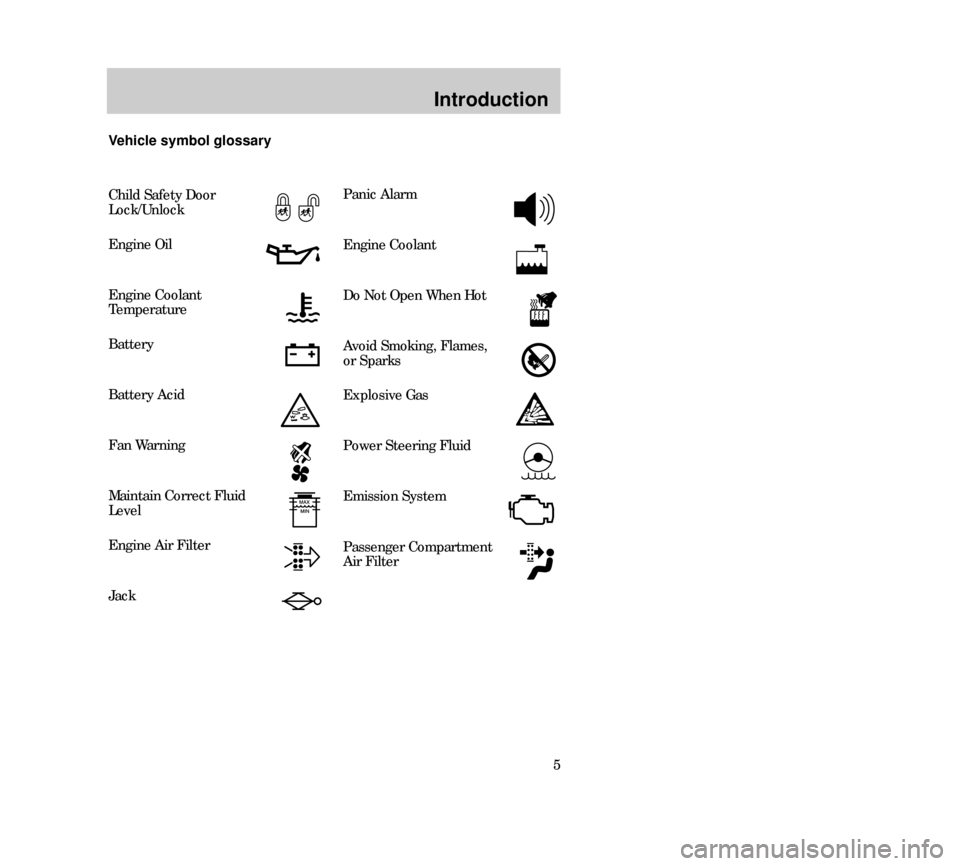
Introduction
5 Vehicle symbol glossary
Child Safety Door
Lock/Unlock
Engine Oil
Engine Coolant
Temperature
Battery
Battery Acid
Fan Warning
Maintain Correct Fluid
Level
Engine Air Filter
Jack
Panic Alarm
Engine Coolant
Do Not Open When Hot
Avoid Smoking, Flames,
or Sparks
Explosive Gas
Power Steering Fluid
Emission System
Passenger Compartment
Air Filter
11MIten 24.6.99 15:01 Uhr Seite 5
Page 6 of 248
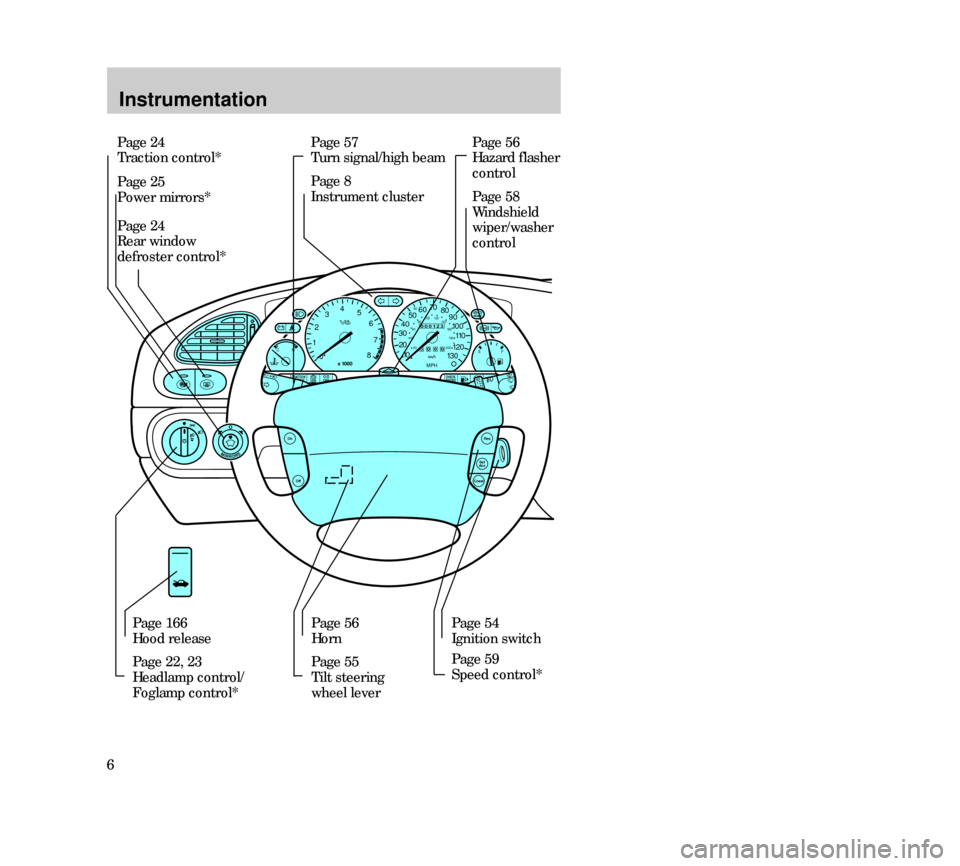
Page 24
Rear window
defroster control*
6
Instrumentation
Page 57
Turn signal/high beam
Page 8
Instrument clusterPage 56
Hazard flasher
control
Page 58
Windshield
wiper/washer
control
Page 166
Hood release
Page 22, 23
Headlamp control/
Foglamp control*Page 56
Horn
Page 55
Tilt steering
wheel leverPage 54
Ignition switch
Page 59
Speed control* Page 24
Traction control*
Page 25
Power mirrors*
TRACTION
CONTROLCHECK
ENGINEO/D
OFF
Res
Set
Acc
CoastOff
On
EF
000123
000010 20 3040506070
80
90
10 0
110
120
13 0MPH
20 406055
80120 10 0
14 0
160
18 0
20012
03
x 1000
4
5
6
7
8
MIRRORS
BRAKE
CH
12MInen 24.6.99 15:02 Uhr Seite 6
Page 54 of 248
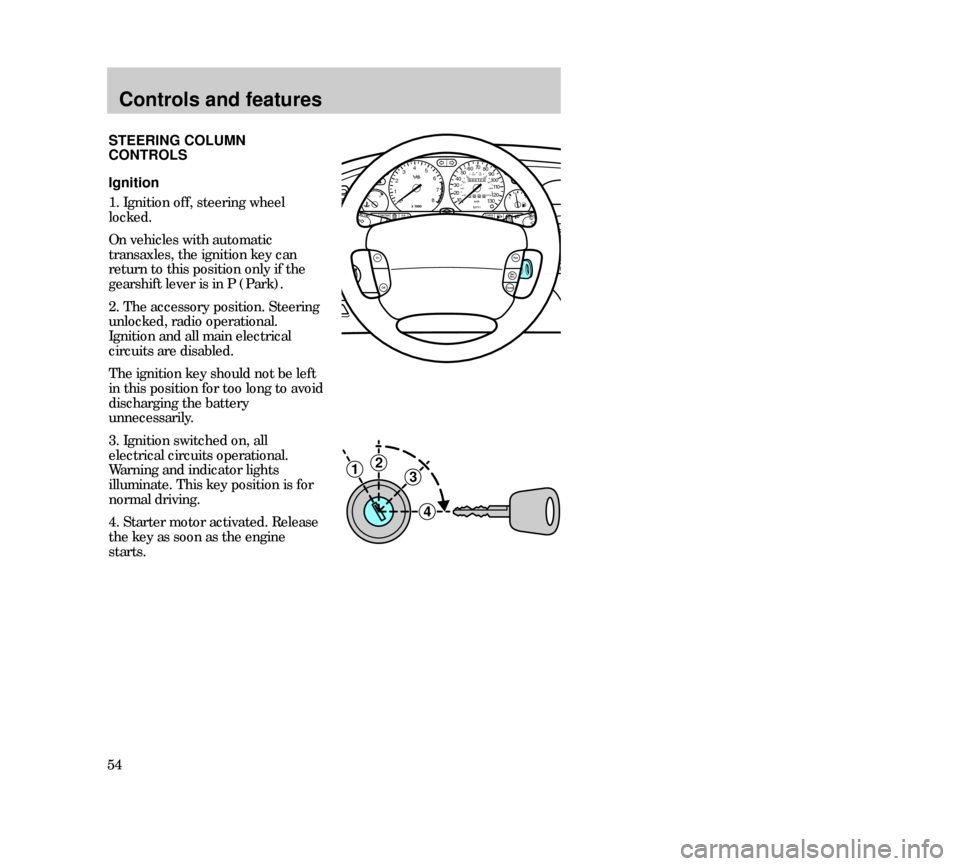
Controls and features
54STEERING COLUMN
CONTROLS
Ignition
1. Ignition off, steering wheel
locked.
On vehicles with automatic
transaxles, the ignition key can
return to this position only if the
gearshift lever is in P (Park).
2. The accessory position. Steering
unlocked, radio operational.
Ignition and all main electrical
circuits are disabled.
The ignition key should not be left
in this position for too long to avoid
discharging the battery
unnecessarily.
3. Ignition switched on, all
electrical circuits operational.
Warning and indicator lights
illuminate. This key position is for
normal driving.
4. Starter motor activated. Release
the key as soon as the engine
starts.
3
4
21
TRACTION
CONTROL
MIRRORS
000123
000010 20 3040506070
80
90
10 0
110
120
13 0MPH20 406055
80120 10 0
14 0
160
18 0
200EF12
03x 1000
4
5
6
7
8
CHECK
ENGINEO/D
OFF
Off
Res
Set
AccCoast
On
CH
13MCfen 24.6.99 15:06 Uhr Seite 54
Page 55 of 248

Controls and features
55
OFF LO PNL/FLR
PANEL
A/CFLOOR
DEF FLR
DEF
MAX
A/C HI/
POWER AUDIO AM/FM
SCAN
SEEK 31245ANSSIDE 1-2EJECTVOLUME
000123
000010 20 3040506070
80
90
10 0
110
120
13 0MPH20 406055
80120 10 0
14 0
160
18 0
200EF12
03
x 1000
4
5
6
7
8
CHECK
ENGINE TRACTION
CONTROLO/D
OFF
MIRRORS
CLOCK
TRACTION
TROL
CH
Tilt steering
Pull the locking lever on the
steering column cover up to adjust
the steering column position.
Secure the wheel by releasing the
lever thereby allowing the lever to
return to the lock position.
Never adjust the steering
wheel while the vehicle is
moving.
13MCfen 24.6.99 15:06 Uhr Seite 55
Page 58 of 248

Controls and features
58Wipers
Lift the windshield wiper lever to
the desired speed interval.
• Intermittent: push lever up to the
first position.
• Low: push lever up to the second
position.
• High: push lever up to the third
position.
For a single wipe, push the lever
downward.
Windshield wipers and washer
Intermittent wiper control
(if equipped)
Rotate the variable intermittent
wiper control to the desired speed.
1 = Short time interval
6 = Extended time interval
Washer
Pull the lever toward the steering
wheel. The washer operates in
conjunction with the windshield
wipers.
13MCfen 24.6.99 15:06 Uhr Seite 58
Page 117 of 248

Driving
117
Two important
rules when
braking in
emergencies with
ABS:
1.
Apply full force
on both brake
and clutch pedal
(if equipped). Braking with ABS
• In an emergency, apply full force
on the brake pedal. In vehicles
with manual transaxles, you must
also depress the clutch pedal. The
anti-lock braking system will be
activated immediately, allowing
you to retain full steering control
of your vehicle and, providing
there is sufficient space, will
enable you to avoid obstacles.
• We recommend that you
familiarize yourself with this
braking technique. However,
avoid taking any unnecessary
risks.
• Although the ABS ensures
optimum braking efficiency,
stopping distances can vary
greatly, depending on the road
surface and conditions. Use of
the ABS cannot eliminate the
dangers inherent in driving too
close to the vehicle in front of you,
hydroplaning, excessive cornering
speed, or poor road surfaces.
2.
Steer around the
obstacle. No matter
how hard you brake,
steering control is
maintained.
22MDren 24.6.99 15:26 Uhr Seite 117
Page 120 of 248
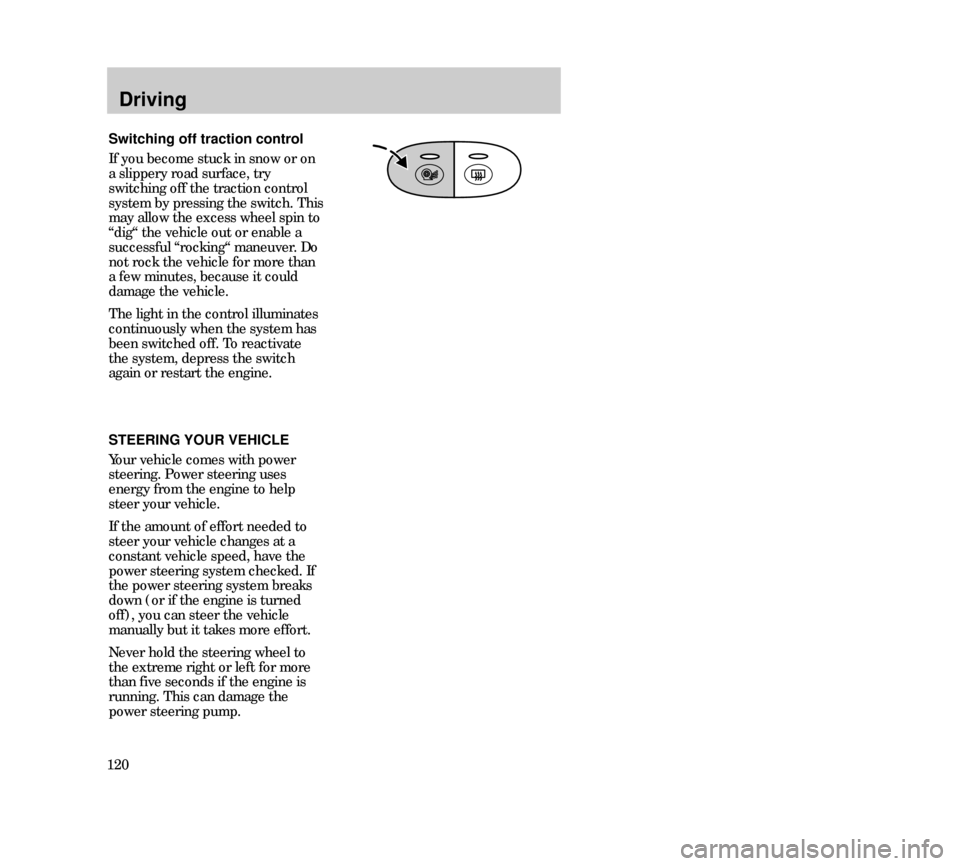
Driving
120STEERING YOUR VEHICLE
Your vehicle comes with power
steering. Power steering uses
energy from the engine to help
steer your vehicle.
If the amount of effort needed to
steer your vehicle changes at a
constant vehicle speed, have the
power steering system checked. If
the power steering system breaks
down (or if the engine is turned
off), you can steer the vehicle
manually but it takes more effort.
Never hold the steering wheel to
the extreme right or left for more
than five seconds if the engine is
running. This can damage the
power steering pump. Switching off traction control
If you become stuck in snow or on
a slippery road surface, try
switching off the traction control
system by pressing the switch. This
may allow the excess wheel spin to
“dig“ the vehicle out or enable a
successful “rocking“ maneuver. Do
not rock the vehicle for more than
a few minutes, because it could
damage the vehicle.
The light in the control illuminates
continuously when the system has
been switched off. To reactivate
the system, depress the switch
again or restart the engine.
22MDren 24.6.99 15:26 Uhr Seite 120
Page 121 of 248

Driving
121 Speed sensitive power steering
(if equipped)
The steering system is speed
sensitive. This means that the
steering effort is light for parking
and heavier for highway driving.
However, if you have to swerve
around an object or another
vehicle, your vehicle will have full
power assist.
TRANSAXLE OPERATION
Automatic transaxle
(if equipped)
Your 2.5 l V6 automatic transaxle
electronically controls the shift feel
by using an adaptive learning
strategy. This feature is designed to
optimize shift smoothness. It is
normal for your transaxle to adjust
during the first few hundred
kilometers (miles) of operation
until the adaptive strategy has
been learned. The adaptive
learning strategy is maintained by
power from the battery. When the
battery is disconnected or a new
battery is installed, the transaxle
must relearn its adaptive strategy.
Optimal shifting will resume within
a few hundred kilometers (miles)
of operation.
Vehicles equipped with an
automatic transaxle are equipped
with a brake-shift interlock feature
that prevents the gearshift lever
from being moved from the P
(Park) position unless the brake
pedal is depressed.Putting your vehicle in gear
You must push the thumb button to
move the gearshift to the position
you choose.
To operate:
1. Start the engine.
2. Depress and hold the brake
pedal.
3. Move the gearshift lever out of
P (Park).
22MDren 24.6.99 15:26 Uhr Seite 121
Page 122 of 248

Driving
122
Overriding the brake-shift
interlock feature
If it is necessary to use this
procedure to move the gearshift
lever, it is possible that a fuse has
blown and the vehicle’s brakelamps
may not be working. Refer to
Fuses
and relaysin the Roadside
emergencieschapter.
If you cannot move the gearshift
lever from P (Park) with the brake
pedal depressed:
1. Turn the ignition off and remove
the ignition key.
2. Apply the parking brake and the
brake pedal.
3. Insert a screwdriver or similar
item about 5 cm (2 inches) into the
square opening to the right of the
gearshift at the base of the console.
4. Rotate the screwdriver point
rearward.
5. Push and hold the thumb button
and move the gearshift.
6. Remove the screwdriver when
the gearshift moves from the P
(Park) position.
The console-mounted gearshift will
lock when you turn the key to the
lock position. When the gearshift is
in any position except P (Park),
the ignition key cannot be turned
to lock or removed from the
steering column. To remove the
key, the gearshift lever must be in
P (Park).Once the gearshift is secure in the
desired position, release the brake
pedal and use the accelerator as
necessary.
22MDren 24.6.99 15:26 Uhr Seite 122
Page 134 of 248
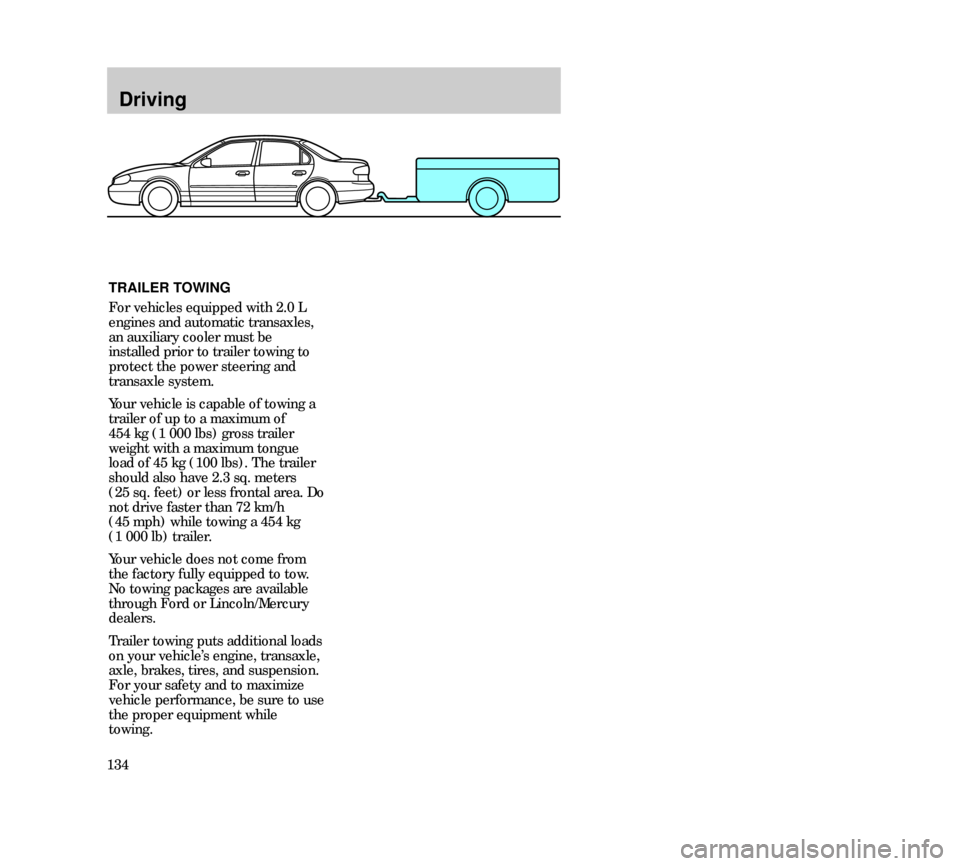
Driving
134TRAILER TOWING
For vehicles equipped with 2.0 L
engines and automatic transaxles,
an auxiliary cooler must be
installed prior to trailer towing to
protect the power steering and
transaxle system.
Your vehicle is capable of towing a
trailer of up to a maximum of
454 kg (1 000 lbs) gross trailer
weight with a maximum tongue
load of 45 kg (100 lbs). The trailer
should also have 2.3 sq. meters
(25 sq. feet) or less frontal area. Do
not drive faster than 72 km/h
(45 mph) while towing a 454 kg
(1 000 lb) trailer.
Your vehicle does not come from
the factory fully equipped to tow.
No towing packages are available
through Ford or Lincoln/Mercury
dealers.
Trailer towing puts additional loads
on your vehicle’s engine, transaxle,
axle, brakes, tires, and suspension.
For your safety and to maximize
vehicle performance, be sure to use
the proper equipment while
towing.
22MDren 24.6.99 15:26 Uhr Seite 134